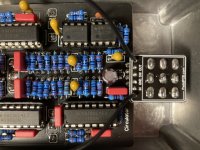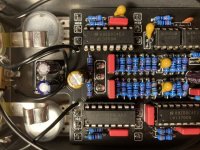jwyles90
Well-known member
Hey all!
I just finished putting together the Circulator build (using a few of Chuck’s mods), and it’s making a pretty substantial pop every time I engage or disengage the pedal. Outside of that everything works as advertised and it sounds great, but the pop is a pretty big bummer.
I used some Tantalum caps that I had on hand since they were the only things that would fit for the 1uF caps, and I’ve never used those before so I’m wondering if maybe they have something to do with it? Does anyone else out there have any tips for isolating whatever could be causing a pop like that? My solder joints all look pretty good to my eyes, but if there’s something obvious that jumps out to you all that I’m not seeing, please let me know! Thanks!



I just finished putting together the Circulator build (using a few of Chuck’s mods), and it’s making a pretty substantial pop every time I engage or disengage the pedal. Outside of that everything works as advertised and it sounds great, but the pop is a pretty big bummer.
I used some Tantalum caps that I had on hand since they were the only things that would fit for the 1uF caps, and I’ve never used those before so I’m wondering if maybe they have something to do with it? Does anyone else out there have any tips for isolating whatever could be causing a pop like that? My solder joints all look pretty good to my eyes, but if there’s something obvious that jumps out to you all that I’m not seeing, please let me know! Thanks!




